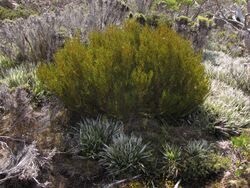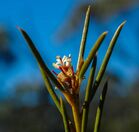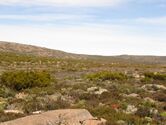Biology:Orites acicularis
| Orites acicularis | |
|---|---|

| |
| Orites acicularis in sub-alpine habitat on Mount Wellington, Tasmania. | |
| Scientific classification | |
| Kingdom: | Plantae |
| Clade: | Tracheophytes |
| Clade: | Angiosperms |
| Clade: | Eudicots |
| Order: | Proteales |
| Family: | Proteaceae |
| Genus: | Orites |
| Species: | O. acicularis
|
| Binomial name | |
| Orites acicularis (R.Br.) Roem. & Schult.
| |
| Synonyms | |
| |
Orites acicularis, commonly known as yellow bush, is an angiosperm endemic to Tasmania, Australia and is a member of the genus Orites within the family Proteaceae. The species was first described in 1810 by Scottish botanist Robert Brown in Transactions of the Linnean Society of London.[1]
Description
Orites acicularis is a yellow-green coloured, woody, rounded shrub growing to approximately 1–1.5 m (3.28–4.92 ft) in height and 0.5–1 m (1.64–3.28 ft) in width, with many ascending branches.[2]
The leaves are of a conspicuous yellow-green colour; they are glabrous, sclerophyllous, approximately 10-35mm long, and rounded.[3] They taper to a sharp point, which is typically more yellow than the rest of the leaf. The adaxial surface of the leaf has a shallow central groove,[4] and the leaf margins are entire. Leaves attach to the woody stem by a 2–5 mm petiole.[3]
Flowering occurs in December, and presents upon a rachis which can be terminal or axillary. The perianth is homochlamydeous; it comprises four white-cream tepals with a groove running along the centre, and curling under to display the pink style.[3] The immature fruit is a green similar to that of the leaves. The fruits are glabrous and oblong, with an elongated tip of reddish brown. When mature, the follicle is lignified and erect, approximately 15 mm long, and boat-shaped.[3] The boat shape is due to the seeds having been released immediately upon maturity.[2][3]
Habitat and distribution
Orites acicularis commonly occurs in Tasmanian sub-alpine mountain plateaus, heaths, and boulder fields with a geology of dolerite, granite, and diorite.[3] Dolerite's slow rate of erosion results in shallow, low-nutrient soils with an abundance of rock fragments. In sub-alpine plateaus, depressions form in the boulder fields.[why?] There, vegetable and mineral matter accumulate, creating bogs or smaller areas of deep soil. Similarly, bolster heath impedes drainage, creating shallow peats.[5]
Other species of plants that commonly grow in this habitat include: Gleichenia alpina, Astelia alpina, Baeckea gunniana, Bauera rubioides, Orites revoluta, Richea sprengelioides, Tasmannia lanceolata, and Eucalyptus coccifera.
Adaptations to solar radiation
Orites acicularis has evolved a number of characteristics to assist with protection from solar radiation in excess of its photosynthetic requirements. Two such adaptations are its abaxial pseudohypodermis and its bundle sheath extensions.[6]
Bundle sheath extensions are formed when sclerenchyma and/or collenchyma cells around a bundle sheath extend to both the adaxial and abaxial epidermis layers of a leaf.[7] The evolution of these bundle sheath extensions in species restricted to open vegetation in the family Proteaceae suggests that it is a recurring adaptation to provide protection against the high levels of solar radiation present.[6] The Orites-type abaxial pseudohypodermis is defined as multiseriate, elongate sclerids forming a reticulum around the sub-stomatal cavities (Jordan et al. 2005) and acts as a further barrier to solar radiation that lies just below the cuticle of the plant.[6]
Etymology
The specific epithet, acicularis, is derived from Latin and means "needle-shaped".[8]
References
- ↑ "Vascular Plants APNI – Australian Plant Name Index". https://id.biodiversity.org.au/instance/apni/458788.
- ↑ 2.0 2.1 Howells, Christine (2012). Tasmania's Natural Flora (2nd ed.). Hobart: Australian Plants Society Tasmania. ISBN 978-0-909830-66-3. OCLC 803605684.
- ↑ 3.0 3.1 3.2 3.3 3.4 3.5 "ABRS Flora of Australia Online Search Results". http://www.anbg.gov.au/abrs/online-resources/flora/stddisplay.xsql?pnid=45103.
- ↑ Jordan, Greg. "Key to Tasmanian Vascular Plants". http://www.utas.edu.au/dicotkey/dicotkey/PROTS/sOrites_acicularis.htm.
- ↑ Crowden, R. K. (2005). "Alpine Vegetation". Vegetation of Tasmania. Canberra: Australian Biological Resources Study. pp. 333–56. ISBN 978-0-646-44512-0.
- ↑ 6.0 6.1 6.2 Jordan, Gregory J.; Dillon, Rebecca A.; Weston, Peter H. (May 2005). "Solar radiation as a factor in the evolution of scleromorphic leaf anatomy in proteaceae". American Journal of Botany 92 (5): 789–796. doi:10.3732/ajb.92.5.789. PMID 21652458. https://www.researchgate.net/publication/51201032.
- ↑ Raven, Peter H.; Evert, Ray F.; Eichhorn, Susan E. (2005). Biology of Plants. New York: W.H. Freeman and Company Publishers. pp. 566. ISBN 0-7167-1007-2. https://archive.org/details/biologyofplants00rave_0.
- ↑ Eggli, Urs; Newton, Leonard E. (2004). Etymological Dictionary of Succulent Plant Names. Berlin, Heidelberg: Springer. p. 1. ISBN 978-3-540-00489-9. https://books.google.com/books?id=u2n5vusQ1DEC&pg=PA1. Retrieved 14 November 2018.
Wikidata ☰ {{{from}}} entry
 |







